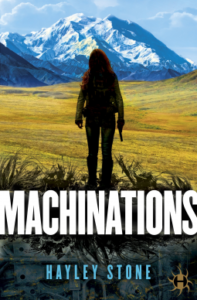
Hayley Stone
Hydra/Random House

Amazon | Barnes & Noble | Goodreads
Rhona remembers dying on the battlefield as Camus held her. When she wakes in a chamber, far from the battlefield, she learns a startling truth: she’s not the original Rhona. She’s a clone.
She races home to a hidden military base where her team of resistance fighters waits for her to lead them against the Machines who’ve chosen to end humanity as a logical solution to establishing world peace. There, she must convince her former allies and the man who first loved Rhona that she’s capable of leading them in a war for humanity’s survival.
I liked that this book paired the elements of a robot/artificial intelligence uprising and the morality/personhood of a human clone together into one fast-paced, fascinating tale. I liked that the plot hinged on whether Rhona could prove her value, not just as a military leader, but as a human being.
I wanted to see that idea juxtaposed against the value of artificial intelligence to kind of explore at what point a machine gains value as an independent life form, if ever. I just thought that would have been interesting—to have a clone on one side of the battle lines compared to AI on the other. Instead, the machines, though highly intelligent, remain largely personality-less, which is okay. However, for the directions the plot pursues, it made sense.
For some reason I really struggled with Camus’s name. I kept forgetting what it was and then wasn’t sure how to pronounce it, which I found a little distracting. I liked that he had this really strong, strategy-oriented approach to life. Rhona’s strengths and weaknesses were very much opposite to his. The fact that they so obviously needed each other and that together they could be such effective leaders definitely amped up the tension between them. Everyone wrestled with whether or not to allow Rhona to resume her former post as commander.
Another total gem in Machinations—the dialogue. I loved Rhona’s snappy one-liners and the way she often said completely absurd things to diffuse tension or make a point. The way she interacted with other characters made her believable and distinct, so I immediately liked her.
What I really didn’t like? The cover. Nothing about that image connects me to the story. I wanted to see the fierce Alaskan winter landscape, the machines. Something like that. The image of the girl on the cover doesn’t look like a warrior back from the dead. I don’t think I’d have picked this up off the shelf in a bookstore.
If you liked These Broken Stars by Amie Kaufman and Meagan Spooner or Illuminae by Amie Kaufman and Jay Kristoff, give Machinations a read. The humor is toned down a little bit compared to Illuminae. The balance of romance to sci-fi reminded me a lot of These Broken Stars.
One of Rhona’s allies is a German man named Ulrich. He expresses himself in German several times, which I enjoyed. I loved it because I actually understood a lot without needing the context or explanation in the narrative. Other than that, most of the named characters appear to be either white American or European. A Japanese doctor treats Rhona’s injuries, and he speaks to the leadership on her behalf. The narrative describes one woman as having dreads and the appearance of an Amazon warrior.
Profanity/Crude Language Content
Moderate profanity used moderately frequently.
Romance/Sexual Content
Camus tests Rhona, asking her about various memories, including the last time they made love. For two sentences-ish, she briefly remembers (more the romance of it than the particulars.)
Spiritual Content
Vague references to prayer. Because Rhona is a clone, the story delves into whether or not she is actually the real Rhona. Is she a slightly different person with the same inherent value, or merely a copy, a scientific abomination? The story discusses some issues of morality concerning human cloning.
Violent Content
When the story opens, Rhona dies of a gunshot wound. Rhona and her allies fight the armed machines. Later, one of Rhona’s allies talks about a former capture by the machines in which he was brutally tortured. He shows scars on his arms from electric burns.
Drug Content
After battles or other trauma, medical staff administer medicine to manage pain and hysteria.
Save
Save
Save
Save